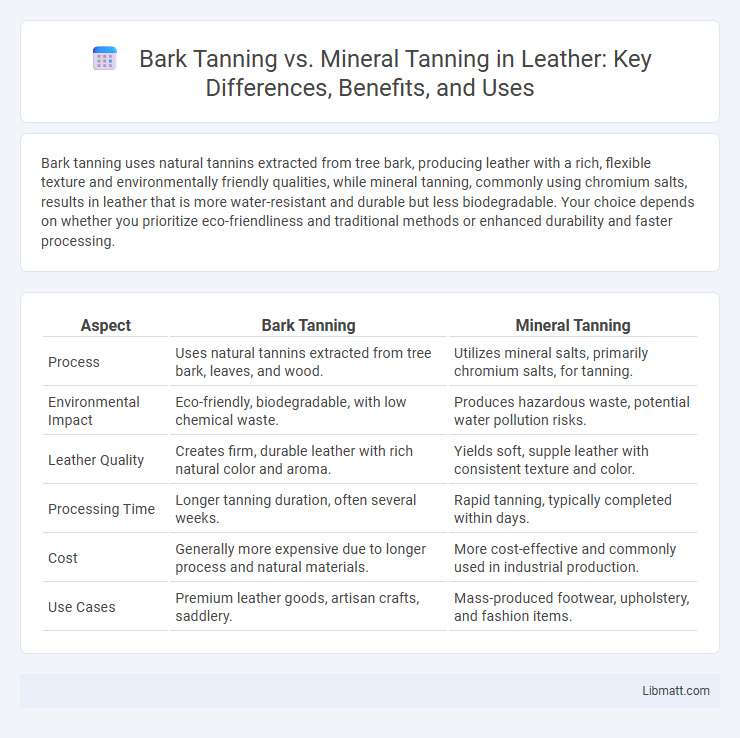Bark tanning uses natural tannins extracted from tree bark, producing leather with a rich, flexible texture and environmentally friendly qualities, while mineral tanning, commonly using chromium salts, results in leather that is more water-resistant and durable but less biodegradable. Your choice depends on whether you prioritize eco-friendliness and traditional methods or enhanced durability and faster processing.
Table of Comparison
| Aspect | Bark Tanning | Mineral Tanning |
|---|---|---|
| Process | Uses natural tannins extracted from tree bark, leaves, and wood. | Utilizes mineral salts, primarily chromium salts, for tanning. |
| Environmental Impact | Eco-friendly, biodegradable, with low chemical waste. | Produces hazardous waste, potential water pollution risks. |
| Leather Quality | Creates firm, durable leather with rich natural color and aroma. | Yields soft, supple leather with consistent texture and color. |
| Processing Time | Longer tanning duration, often several weeks. | Rapid tanning, typically completed within days. |
| Cost | Generally more expensive due to longer process and natural materials. | More cost-effective and commonly used in industrial production. |
| Use Cases | Premium leather goods, artisan crafts, saddlery. | Mass-produced footwear, upholstery, and fashion items. |
Introduction to Leather Tanning Methods
Bark tanning, also known as vegetable tanning, utilizes natural tannins extracted from tree bark, leaves, and other plant sources to transform animal hides into durable leather with a rich, earthy aroma and a firm texture. Mineral tanning, primarily chrome tanning, involves using chromium salts to produce leather that is softer, more water-resistant, and faster to process compared to vegetable-tanned leather. Each tanning method impacts the leather's environmental footprint, color retention, aging properties, and end-use applications.
What is Bark Tanning?
Bark tanning, also known as vegetable tanning, uses tannins extracted from tree bark, leaves, and other plant materials to transform animal hides into durable leather. This eco-friendly method produces leather that is firm, water-resistant, and develops a rich patina over time, making it ideal for high-quality, long-lasting products. Your choice of bark-tanned leather supports sustainable practices and results in leather with unique natural characteristics.
What is Mineral Tanning?
Mineral tanning, primarily using chromium salts, alters the collagen structure in animal hides to produce durable, flexible leather resistant to water and heat. This process is faster than bark tanning, typically taking less than a day, and results in a uniform product widely used in automotive and fashion industries. Chromium-tanned leather offers superior softness and color retention but poses environmental challenges due to heavy metal waste.
Key Differences Between Bark and Mineral Tanning
Bark tanning, also known as vegetable tanning, uses natural tannins extracted from tree bark, providing leather with a firm texture and rich color, while mineral tanning primarily involves chromium salts, resulting in softer, more pliable leather. The tanning time varies significantly, with bark tanning taking several weeks due to the gradual absorption of tannins, whereas mineral tanning can be completed within a day or two. Bark tanned leather is environmentally friendly and biodegradable, contrasting with mineral-tanned leather, which poses environmental concerns due to chromium waste and chemical usage.
Environmental Impact: Bark vs Mineral Tanning
Bark tanning, also known as vegetable tanning, uses natural tannins extracted from tree bark and other plant materials, resulting in biodegradable leather with a significantly lower environmental footprint compared to mineral tanning. Mineral tanning typically involves chromium salts, which are toxic and pose substantial risks to water pollution and soil contamination if not properly managed. The biodegradability and lower toxicity of bark-tanned leather make it a more sustainable and eco-friendly choice in leather production.
Durability and Quality of Leather
Bark tanning produces leather known for its exceptional durability and rich, natural texture due to the vegetable tannins used, which penetrate deeply into the hide, enhancing strength and breathability. Mineral tanning, typically using chromium salts, results in softer, more flexible leather that is resistant to water and stains, though sometimes less durable over long-term use compared to bark-tanned leather. Your choice between bark and mineral tanning will impact the leather's lifespan and quality, depending on whether you prioritize natural robustness or flexible practicality.
Processing Time and Efficiency
Bark tanning, also known as vegetable tanning, requires significantly longer processing time, often several weeks, due to the natural extraction of tannins from tree bark, making it less efficient compared to mineral tanning. Mineral tanning, particularly chrome tanning, drastically reduces processing time to a few days by using chromium salts, enhancing production efficiency and allowing faster turnaround. Your choice between these methods impacts both the timeline and operational workflow, with bark tanning favoring traditional, durable leather and mineral tanning prioritizing speed and pliability.
Cost Comparison: Bark vs Mineral Tanning
Bark tanning, utilizing natural tannins from tree bark, typically incurs higher labor and raw material costs compared to mineral tanning, which relies on chromium salts and is more cost-effective for large-scale production. Mineral tanning offers faster processing times and greater uniformity, reducing overall expenses despite environmental and disposal costs. The initial investment and environmental compliance can make bark tanning more expensive, though it yields eco-friendly leather with unique aesthetic qualities.
Common Uses and Applications
Bark tanning, also known as vegetable tanning, is commonly used for producing durable leather goods such as saddles, belts, and wallets due to its natural, flexible finish and eco-friendly process. Mineral tanning, primarily chrome tanning, is widely applied in manufacturing softer leather products like shoes, upholstery, and fashion accessories because of its rapid processing time and enhanced water resistance. Both methods serve distinct purposes in the leather industry, with bark tanning favored for traditional, sturdy items and mineral tanning preferred for mass-produced, pliable leather goods.
Choosing the Right Tanning Method
Choosing the right tanning method depends on your priorities such as environmental impact, leather quality, and durability. Bark tanning, using natural tannins from tree bark, produces eco-friendly, flexible, and breathable leather, ideal for sustainable products. Mineral tanning, typically involving chromium salts, offers faster processing and creates water-resistant, durable leather suitable for heavy-duty applications.
Bark tanning vs mineral tanning Infographic

 libmatt.com
libmatt.com